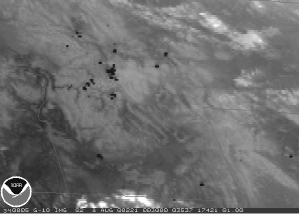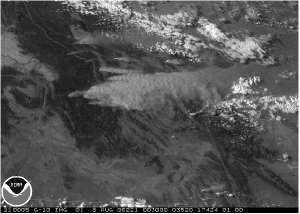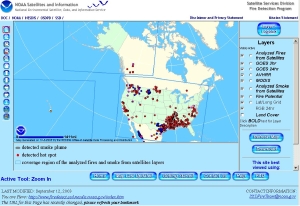
|
|
2005 August — Vol. XIV, No. 6 |
|
Current Issues |
|
|
|
|

|
|
|
|
|
|
|
|
|
|
|
|
|
|
EOM August 2005 > Departments > Fire!
Operational Fire and Smoke Monitoring In NESDIS' Satellite Services Division
By George Stephens, Donna McNamara, and Mark Ruminski
Introduction
The Hazard Mapping System (HMS) is an operational system that capitalizes on existing sensors on environmental satellites to create a daily fire and smoke analysis over the United States, Canada, and Mexico. Automated fire detections are incorporated into the system from Geostationary Operational Environmental Satellite (GOES) Imager, Advanced Very High Resolution Radiometer (AVHRR), and Moderate Resolution Imaging Spectroradiometer (MODIS). A key component is quality control by an analyst who inspects all available imagery and automated fire detects, deletes detects believed to be false alarms, and adds fires that the automated routines have not detected. Nighttime lights imagery from Defense Meteorological Satellite Program Operational Linescan System (DMSP/OLS) and a variety of static layers are available to assist the analyst. HMS products are available in ASCII, graphic, and Geographic Information System (GIS) formats. Future plans include operationally running several of the automated algorithms on global imagery.
Background
Biomass burning affects Earth's ecosystems and climate, altering landscape and biologic structure and emitting large amounts of greenhouse gases and aerosols, which may interact with cloud droplets and alter Earth's radiation budget. Remote sensing is the most efficient and economical means of routinely monitoring fires over large areas. Satellite observations can provide timely information on fire development and damage and have the potential to help authorities make decisions regarding fire fighting and reducing the impact of fires on the population. Research on the use of environmental satellites to detect fires has been conducted at the National Environmental Satellite, Data, and Information Service (NESDIS) for over twenty years. Matson and Dozier demonstrated the ability to detect and characterize fires with sub-pixel resolution. Matson et al. correlated satellite-derived hot spots with confirmed ground observations.
In the summer and autumn of 1997, pollution caused by smoke from extensive wildfires in Indonesia prompted requests from United Nations aid organizations for routine imagery of fire and smoke in the area. In the spring of 1998, massive fires burned across large areas of Florida, Mexico, and parts of Central America. Resultant large smoke plumes affected a large section of the United States, from Texas to the Mid-Atlantic states, and the Florida fires caused considerable damage to homes and closed Interstate highways. In response, the NOAA/NESDIS Satellite Services Division (SSD) began producing a regular analysis of smoke plumes and fires over these areas during the 1998 fire season as a regional graphic available to users via the Internet.
The Hazard Mapping System (HMS)
The initial product was phased out in June 2002 and the current HMS became operational. The HMS is an interactive system allowing satellite analysts to manually integrate data from various automated fire detection algorithms with imagery from geostationary and polar-orbiting satellites, resulting in a quality-controlled display of the locations of fires and major smoke plumes in the continental United States, Mexico, and Canada.


Figure 1a and 1b: Fires as seen by GOES. In 1a hotspots appear as dark spots on the 4 micron imagery. In 1b smoke is clearly visible from large fires in Idaho and Montana on 2000 August 8. Click on image to see enlarged.
The product relies heavily on imagery from NOAA's Geostationary Operational Environmental Satellite (GOES) series, providing half-hourly detection over the United States. These frequent updates allow for detection of short-lived fires. Bands employed are visible wavelengths for smoke detection and 3.9 microns for sensing fires (Figures 1a and 1b). Resolution is 1 kilometer at satellite sub-point for the visible channel and 4 kilometer at sub-point for the 3.9 micron channel.
While the high temporal frequency of the GOES satellites allows for detection of many fires, the 4 kilometer resolution limits the size, intensity, and location accuracy of fires that can be detected. GOES misses small fires not burning hot compared to the surrounding ground temperature. To augment the GOES capabilities, NOAA's Polar Environmental Operational Satellites (POES) are employed. They also have visible and 3.9 micron channels, both at 1.1 kilometer resolution. The finer resolution allows for earlier detection of small fires, and shows finer location and detail. However, the imagery is available only once every 12 hours for each satellite.
The primary data source used for the smoke analysis is animated 1 kilometer GOES visible imagery, used in discriminating between smoke and clouds. Smoke plumes are most easily observed when there is a low sun angle, just after sunrise and just before sunset. The areal extent of smoke is manually drawn by the analyst and included with the depiction of fires. Currently there is no attempt to assign a height or density to the smoke although automated algorithms are being investigated for estimating Aerosol Optical Depth (AOD). By continual analysis it is easy to track large plumes that drift far from their source. An experimental descriptive smoke text product has recently been implemented as a complement to the graphic depiction of smoke and is accessed from the HMS Web page.
Continued below ...
|
|
|
|
|
|
|
|
Various automated detection algorithms have been developed which can identify hot spots in the satellite imagery.
The Wildfire Automated Biomass Burning Algorithm (WF_ABBA) product was developed by Dr. Elaine Prins while at the Cooperative Institute for Meteorological Satellite Studies (CIMSS), at the University of Wisconsin. This product, which became operational within SSD in 2002 August, provides coverage over North America every half-hour. The GOES WF_ABBA is a contextual multi spectral (primarily 3.9 and 10.7 micron) algorithm which uses dynamic local thresholds derived from the GOES satellite imagery and ancillary databases to locate fire pixels and provides identification of fires and estimates of the sub pixel area and mean temperature of the fires.
The Fire Identification, Mapping, and Monitoring Algorithm (FIMMA), which detects fires from Advanced Very High Resolution Radiometer (AVHRR) data from the NOAA polar orbiting satellites, was developed by Dr. Ivan Csiszar while at the Cooperative Institute for Research in the Atmosphere, working at the NOAA/NESDIS Office of Research and Applications (ORA). The latest version uses geo corrected AVHRR data over the United States (including Alaska and Hawaii) and can be run for any pass that has 3.7 micron measurements. The algorithm builds on AVHRR and MODIS algorithms described by Giglio et al. and by Li et al. It uses AVHRR channels 2 (.9 micron), 3b (3.7 micron), 4 (10.8 micron), and 5 (12 micron). The algorithm is contextual with tests for satellite noise, clouds, hot surfaces, sun glint, and surface type. This product is considered pre-operational at NOAA; validation and algorithm refinement continues.
SSD receives Moderate Resolution Imaging Spectroradiometer (MODIS) data and fire products from NOAA's MODIS Near Real Time Processing System. MODIS instruments onboard the NASA TERRA and AQUA polar-orbiting satellites provide 36 spectral channels with resolution ranging from .25 kilomters to 1 kilometer. These data have proved an important asset in operational fire detection. The fire algorithm was developed by the MODIS Fire and Thermal Anomalies team.
These automated detection algorithms do a very good job of identifying potential fires, but false detects can be a problem. For example, heated ground can saturate the 3.9 micron sensor, making it impossible to discriminate. The current operational NOAA satellites were not designed for fire detection, but future satellites will have a higher 3.9 micron saturation temperature. The automated algorithms are initiated as soon as data are available. Products are released as soon as possible for those users who need immediate detects and can accept a higher rate of false detects. At 1 pm Eastern time, the fire shift begins. The analyst prepares a preliminary product as the fires begin to develop that day. This preliminary analysis is updated throughout the fire shift, which ends at 11 pm Eastern time. The product for the day before is updated one more time at the start of the next day's shift to ensure that the best product is sent to the archive.
The current analysis process has several limitations:
- There is no way to discriminate wildfires from agriculture or controlled burns.
- The 3.9 micron imagery cannot see through clouds, other than thin cirrus clouds.
- Small cool fires and those burning below thick overgrowth may go undetected.
- Smoke is difficult to detect in visible imagery with a high sun angle or against a surface with a high albedo.
- Fires often are masked by high surface temperatures and reflectivity that cause the sensor to saturate.
Data Availability

Figure 2: HMS GIS interface. Click on image to see enlarged.
The primary data delivery mechanism for the smoke and fire product is a Geographic Information System (GIS) webpage at http://www.firedetect.noaa.gov/viewer.htm (Figure 2), allowing the products to serve a much large user community than traditional remote sensing users. Land and air quality managers have found this system very useful. Users have the capability to overlay WF_ABBA, FIMMA, and MODIS fire detects, and can zoom to the county level. Ancillary layers, such as geopolitical boundaries, lakes and rivers, major highways, land cover, and fire potential (from NOAA/National Weather Service Storm Prediction Center) are available.
Users can download products directly from an anonymous FTP site at gp16.ssd.nesdis.noaa.gov, or via the web. Products are available in text, graphic or GIS formats. An archive of the HMS and WF_ABBA products has been established at NGDC at http://map.ngdc.noaa.gov/website/firedetects/viewer.htm.
The U.S. Department of State funded Scientific Fellows from Mexico and Guatemala in 2004 and 2005 to visit SSD and perform the HMS analysis for Central America during the burning season. This research was utilized by Mexican government agencies in strategic and tactical operations. Based on its usefulness, the HMS software is currently being implemented in Mexico.
Future of HMS
The HMS, with significant analyst intervention, will continue to be refined for North America to meet the needs of U.S. land and air quality managers, weather forecasters, and emergency planners.
Global coverage has been requested by the emissions modeling community and will rely on improvements in the automated algorithms. Efforts have begun to adapt the WF_ABBA algorithm to Meteosat Second Generation (MSG) and Multi-functional Transport Satellite (MTSAT). With the launch of METOP (Meteorological Operational satellite) in late 2005, AVHRR data will be available globally at 1 kilometer resolution. MODIS fire detects are already available globally and MODIS is serving as excellent preparation for VIIRS (Visible Infrared Imager/Radiometer Suite), the replacement for AVHRR on the National Polar-orbiting Operational Environmental Satellite System (NPOESS). Analysts' experience will be used to develop methods to integrate all satellite sources and the analyst will continue to perform quality control. ![]()
Further Reading
- L. Giglio, J.D. Kendall, and C.O. Justice, C. O., "Evaluation of Global Fire Detection Algorithms Using Simulated AVHRR Infrared Data," in International Journal of Remote Sensing, 20, 1947-1985, 1999.
- C.O. Justice, L. Giglio, S. Korontzi, J. Owens, J.T. Morisette, D. Roy, J. Descloitres, S. Alleaume, F. Petitcolin, and Y. Kaufman, "The MODIS fire products," in Remote Sensing of Environment, 83:244-262, 2002.
- Y. J. Kaufman, C.O. Justice, L.P. Flynn, J.D. Kendall, E.M. Prins, L. Giglio, D.E. Ward, P. Menzel, and A.W. Setzer, "Potential global fire monitoring from EOS MODIS," in Journal of Geophysical Research, 103, 31955, 32215 32238, 1998.
- Z. Li, Y.J. Kaufman, C. Ichoku, R. Fraser, A. Trishchenke, L. Giglio, J. Jin, and X Yu, "A Review of AVHRR-Based Active Fire Detection Algorithms: Principles, Limitations, and Recommendations," in Global and Regional Vegetation Fire Monitoring from Space: Planning a Coordinated International Effort, SPB Acadenic Publishing, The Hague, Netherlands, pp. 199-225, 2001.
- M. Matson and J. Dozier, "Identification of subresolution high temperature sources using a thermal IR sensor," in Photogrammetry Engineering Remote Sensing, 47:1311, 1981.
- M. Matson, S.R. Schneider, A. Aldridge, and B. Satchel, "Fire Detection Using the NOAA Series Satellites", NOAA-NESS Technical Report 7 (NOAA, Washington DC, 1984).
- E.M. Prins and W. P. Menzel, "Geostationary satellite detection of biomass burning in South America," in International Journal of Remote Sensing, 13, 2,783 2,799, 1992
- E.M. Prins, J. M. Feltz, W. P. Menzel, and D. E. Ward, "An overview of GOES 8 diurnal fire and smoke results for SCAR B and the 1995 fire season in South America," in Journal of Geospatial Research, 103, D24, pp. 31,821 31, 836, 1998.
- E. Prins, J. Schmetz, L. Flynn, D. Hillger, and J. Feltz, "Overview of current and future diurnal active fire monitoring using a suite of international geostationary satellites," in Global and Regional Wildfire Monitoring: Current Status and Future Plans, SPB Academic Publishing, The Hague, Netherlands, pp. 145 170, 2001.
Acknowledgments
The authors would like to acknowledge the assistance of Davida Streett, Jamie Kibler, John Simko, Greg Gallina, Regis Walter (NESDIS/OSDPD/SSD); Bruce Ramsay, Elaine Prins, and Chris Schmidt (NESDIS/ORA); Tad Franson, Yi Song, Brian Dyke, and Jason Taylor (RS Information Systems, Inc.); and Chris Elvidge, Ted Habermann (NGDC).
Donna McNamara is a physical scientist with NOAA's National Environmental Satellite Data and Information Service, Satellite Services Division. In January 2001, she joined NOAA as a federal employee, becoming the Environmental Applications Team leader, overseeing the development of new applications using environmental satellites. Her primary project was to establish an operational fire and smoke detection program. In 2004, Ms McNamara became the Ozone product area lead. George Stephens has been a hydrologist with NOAA's National Environmental Satellite, Data, and Information Service, Satellite Products Branch since 1982. His current projects include participation in development of GIS-based satellite fire and smoke monitoring systems, exploitation of MODIS data for airborne volcanic ash detection, image analysis of environmental disasters, and implementation of the International Charter on Space and Major Disasters. Currently he is the Satellite Services Division's Product Area Lead for fire monitoring and Operational Significant Event Imagery. Mark Ruminski is the fire team leader for the Satellite Analysis Branch of NOAA NESDIS which produces the daily quality-controlled fire and smoke product. He has worked with other team members of the Satellite Services Division to establish the Hazard Mapping System which is the main tool used for creating the analysis. He has worked for NOAA for more than 20 years, with the bulk of that time spent in operational analysis with NESDIS.About the Authors
|
|
|
©Copyright 2005-2021 by GITC America, Inc. Articles may not be reproduced, in whole or in part, without prior authorization from GITC America, Inc. |